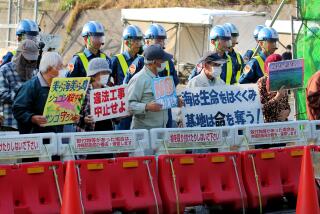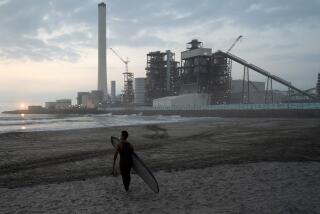Checkups Are a Lifeline for Hiroshima Survivors
- Share via
Kaz Suyeishi describes herself as “an old jalopy car” needing a dozen replacement parts, a tuneup and a new transmission.
And she is grateful for the Japanese doctors who travel half-way around the world every two years to inspect her engine and issue her a guarantee for a few more miles.
Suyeishi, 58, is one of about 200 atomic bomb survivors now living in Southern California. On Aug. 6, 1945, her neighborhood was destroyed when the United States bombed Hiroshima, leveling her home and sending thousands of “walking ghosts” into the streets.
A Team of Five
On Saturday, Suyeishi and about 25 other survivors of the Hiroshima blast--and a second three days later in Nagasaki--received free medical examinations from a team of five doctors from Japan who specialize in radiation exposure.
The biennial checkups, sponsored by the Japanese government and the Hiroshima Medical Assn., have been offered throughout the United States since 1977. The doctors will continue examining survivors--or hibakusha, as they are known in Japanese--through Tuesday at City View Hospital in Lincoln Heights before moving on to Seattle and Hawaii.
After receiving a relatively clean bill of health Saturday, Suyeishi, who still experiences back and leg pains that she attributes to the atomic blast, said: “I’m a jalopy car, but believe me, this Japanese car is good-made. All you need is to put some gas in and go.”
Despite the 40 years that have elapsed since the bombing, many hibakusha remain susceptible to cancer, leukemia and reproductive disorders, the medical team said. Survivors suffer from a high rate of hypertension, liver disease, diabetes, hypothyroidism and heart disease. Many live in fear of dying and are plagued by nightmares and other psychological problems.
Most Are Women
The checkup includes both a physical and psychological exam, blood test, urinalysis and electrocardiogram. Women, who outnumber male survivors living in the United States by 3 to 1, also receive a gynecological exam.
Dr. Fumio Doko, head of the medical team, said the biennial trips are important to survivors in the United States who, because of limited English skills, may have difficulty expressing their symptoms and fears to American doctors.
In addition, Doko said research and treatment in atomic exposure has progressed further in Japan than in the United States because of the more than 100,000 survivors still living in Hiroshima.
“Some hibakusha have much anxiety about the radiation, even though it has been 40 years,” Doko said. “In Japan, hibakusha know more about the effects of radiation--they are better educated about it.”
A Kind of Peace
For Suyeishi, the exam provides peace of mind and helps relieve the lingering fears of health problems associated with radiation exposure.
“To us, it’s a rescue team,” she said. “Every two years, they come thousands and thousands of miles to examine us--to rescue us. If they say, ‘You’re fine,’ we feel better.”
More to Read
Sign up for Essential California
The most important California stories and recommendations in your inbox every morning.
You may occasionally receive promotional content from the Los Angeles Times.










